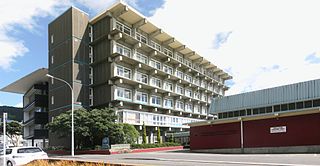
Kathleen Mansfield Murry was a New Zealand writer and critic who was an important figure in the modernist movement. Her works are celebrated across the world and have been published in 25 languages.

Kelburn is a central suburb of Wellington, the capital city of New Zealand, situated within 1 kilometre (0.62 mi) of the central business district.

Karori is a suburb located at the western edge of the urban area of Wellington, New Zealand, 4 kilometres from the city centre and is one of New Zealand's most populous suburbs, with a population of 15,330 in June 2024. The name Karori used to be Kaharore and is from the Māori language. No Māori lived in the area, when the first European settlers came to Karori in the 1840s. The first settler in Karori cleared 20 acres of forest on his section with his younger brother Moses and advertised its sale in December 1841.

Lambton Quay is the heart of the central business district of Wellington, the capital city of New Zealand.

Premier House is the official residence of the prime minister of New Zealand, located at 260 Tinakori Road, Thorndon, Wellington, New Zealand.

The Wellington tramway system (1878–1964) operated in Wellington, the capital of New Zealand. The tramways were originally owned by a private company, but were purchased by the city and formed a major part of the city's transport system. Historically, it was an extensive network, with steam and horse trams from 1878 and then electric trams ran from 1904 to 1964, when the last line from Thorndon to Newtown was replaced by buses.

Wellington Girls' College was founded in 1883 in Wellington, New Zealand. At that time it was called Wellington Girls' High School. Wellington Girls' College is a year 9 to 13 state secondary school, located in Thorndon in central Wellington.

Te Aro is an inner-city suburb of Wellington, New Zealand. It comprises the southern part of the central business district including the majority of the city's entertainment district and covers the mostly flat area of city between The Terrace and Cambridge Terrace at the base of Mount Victoria.

The Wellington Urban Motorway, part of State HIghway 1, is the main road into and out of Wellington, New Zealand. It is 7 km long, ranges from three to seven lanes wide, and extends from the base of the Ngauranga Gorge into the Wellington CBD.

Northland is a suburb in west-central Wellington, New Zealand. Not far from Victoria University it also includes low-priced accommodation popular with young students. It borders the suburbs of Highbury, Kelburn, Thorndon, Wilton, Wadestown and Karori. Northland is populated by a mix of university students, young professionals and families. Part of the area was known as Creswick until the late 19th century when new roads and building sites were developed by the landowner, C J Pharazyn, who marketed the whole area as Northland. At that time it was described in The Evening Post as "Wellington's best suburb".

Te Ahumairangi Hill is a hill running for over 100 hectares through the Town Belt of Wellington, New Zealand. It was renamed Te Ahumairangi Hill as part of the Port Nicholson Block Claims Settlement Act 2009. The suburb of Wadestown lies to the north, with Wilton, and Northland to the west and south-west. Te Ahumairangi lies within Thorndon which continues to its south-east.

Katherine Mansfield House and Garden was the early childhood home of Katherine Mansfield, a prominent New Zealand author. The building, located in Thorndon, Wellington, is classified as a Category 1 Historic Place by Heritage New Zealand.

The reclamation of Wellington Harbour started in the 1850s, in order to increase the amount of usable land for the then new City of Wellington. Land plots in the early city were scarce, with little room for public buildings and parks, as well as inadequate dockside areas for shipping. Reclamation progressively advanced into the harbour throughout the 19th and 20th centuries, providing room for public, commercial and industrial areas for the city. Large reclamations were made in the 1960s and '70s to meet the demands of container shipping and new cargo handling methods.

Goldie's Brae is a historic building in Wadestown, Wellington, New Zealand classified as a "Category I" historic place by the New Zealand Historic Places Trust. It is considered remarkable for its relatively new construction material, concrete, and its eccentricity of design. It was designed by its original owner Dr Alexander Johnston, the Provincial Surgeon of Wellington.
Pipitea Point railway station, a temporary building for the Hutt and Masterton railway, was Wellington's first railway station opened on 14 April 1874 with the Hutt Valley Line. The railway line from Wellington to Lower Hutt was started in 1872 and opened in 1874.

Sir Harold Beauchamp was a New Zealand businessman and later two times chairman of the Bank of New Zealand. He is remembered as the father of author Katherine Mansfield.
Ngāti Rakaipaaka is a Māori hapū (subtribe), from the Nūhaka area of northern Hawke's Bay on New Zealand's North Island. It is a subtribe of Ngāti Kahungunu.

Wadestown is a northern suburb of Wellington, located about 2–3 km (1.2–1.9 mi) by road from the Wellington central business district and the New Zealand Parliament Buildings.

Pipitea is a central suburb of Wellington, in the Wellington region of New Zealand's North Island.
Te Ara Tupua is a project to construct a 12-kilometre-long (7.5 mi) safe cycling and walking path in New Zealand, between Melling in Lower Hutt and central Wellington. New Zealand Transport Agency / Waka Kotahi (NZTA) leads the project, with involvement from mana whenua Taranaki Whānui and Ngāti Toa, Wellington City Council, Hutt City Council and Greater Wellington Regional Council. The project is divided into three sections: Melling to Petone, Petone to Ngauranga, and Ngauranga to Wellington's central business district. NZTA estimates that by 2030, people will make over 2100 bike trips, 360 walking or running trips and 300 trips on e-scooters on the path each weekday.



































